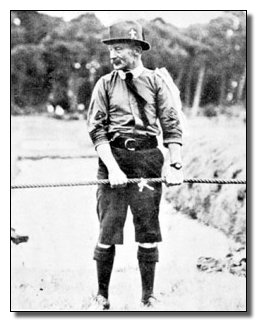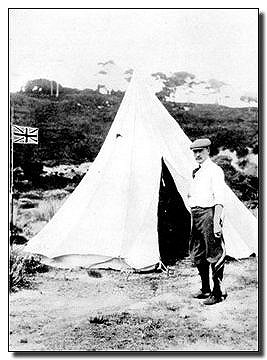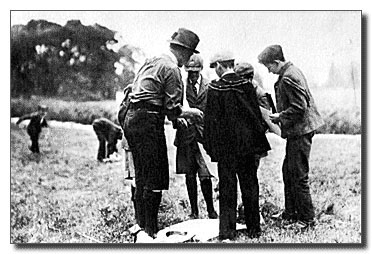The Boys
The camp consisted of 20 boys form all kinds of backgrounds, 10 of them were from the Public schools of Eton and Harrow and were the boys of Army friends and other acquaintances of BP while of the remaining 10, 7 were from the Bournemouth Boys Brigade and 3 from the Poole Boys Brigade, there was also Donald Baden-Powell, BP's 9 year old nephew and Simon Rodney, older brother of George, James and William on camp.
The boys were divided up into 4 Patrols called Curlews, Ravens, Wolves and Bulls. For patrol identification, the boys were given long, wool streamers in different colors to pin on their left shoulder - green for Bulls, blue for Wolves, yellow for Curlews, and red for Ravens.
The senior boy in each patrol was assigned as Patrol Leader and was given a flag with the animal of their Patrol on it. Each patrol Leader was given full responsibility for the behavior of his Patrol at all times, in camp and in the field. The Patrol was the unit to work or play, and each patrol was camped in a separate spot.
Each Patrol was assigned an army Tent to sleep in and a fifth tent was used by BP, his nine year old nephew Donald Baden-Powell, who served as his orderly; and his assistant Scoutmasters, an old Army friend named Kenneth McLaren and Percy W. Everett. Also on the campsite was an army cook tent and an open-sided marquee tent for shelter in a storm.
WOLVES - B. Wroughton (Patrol Leader), C.S. Curteis, A. Primmer, Bertie Watts, B. Tarrant
BULLS - B. Evans-Lombe (Patrol Leader), J. Evans-Lombe, B. Blandford, A. Vivian, W. Rodney
CURLEWS - G. Rodney (Patrol Leader),Percy Medway, J. Rodney, T. Bonfield, H. Collingbourne
RAVENS - H. Emley (Patrol Leader), R. Giles, M. Noble, R. Grant, H. Noble
Key to Patrol members background
Public School Boys , 1st Bournemouth Boys Brigade, 1st Poole Boys Brigade
Simon Rodney doesn't seem to have been assigned to a specific Patrol but some sources say he may have been in the Wolves, but this is unconfirmed.
Each boy was given a brass fleur de lys badge which was fastened on to his coat; when he had passed a few tests ( knots, tracking, the Flag) he was given another brass badge to fasten below the first, a scroll with the words "Be Prepared" on it. Khaki scarves were also issued
The Program
The daily program was as follows:
6:00 a.m.  Turn out, air bedding, milk and biscuits
Turn out, air bedding, milk and biscuits
6:30 a.m.  Exercises
Exercises
7:00 a.m.  Notices of days activities with demonstrations
Notices of days activities with demonstrations
7:30 a.m.  Clean camp
Clean camp
7:55 a.m.  Parade. Flag break followed by Prayers. Breakfast
Parade. Flag break followed by Prayers. Breakfast
9:00 a.m.  Scouting practices
Scouting practices
12 noon  Bathing
Bathing
12:30 p.m. Lunch
1-2:15 p.m.  Rest
Rest
2:30 p.m.  Scouting practices
Scouting practices
5:00 p.m.  Tea
Tea
6:00 p.m.  Camp games
Camp games
7:15 p.m.  Rub down and change
Rub down and change
8:00 p.m.  Supper
Supper
8:15 p.m.  Campfire yarns. Short exercises ( breathing, etc.)
Campfire yarns. Short exercises ( breathing, etc.)
9:15 p.m.  Prayers
Prayers
9:30 p.m.  Turn in. Lights out.
Turn in. Lights out.
Each day had a different theme camping, observation, wood craft and so on. Under camping such things as how to make a natural shelter out of branches, twigs and leaves, knotting, fire lighting and cooking were undertaken
Below is an outline of the program which BP produced for the camp. (taken from 75 years of Scouting a Scouting Magazine supplement 1982 - Scouting Magazine 1982)
DAY 1 Preliminary
After settling into camp, formation of patrols and distribution of duties, orders etc each subject of the camp was explained with demonstrations. Patrol Leaders received a special course of instruction in he field for them to impart subsequently to their Patrols
DAY 2 Camping
Camp resourcefulness. Hut and mat making. Knots, Fire-lighting, cooking, health and sanitation. Endurance. Finding way in strange country. Boat management
DAY 3 Observation
Noting and memorizing details near and far. Landmarks etc. Tracking. Deducing meaning from tracks and signs. Training eyesight, etc
DAY 4 Woodcraft
Study of animals and birds, plants, stars, etc, stalking animals. Noticing details of people. Reading their character and condition, thereby gaining sympathy, etc
DAY 5 Chivalry
Honor, code of the knights. Unselfishness. Courage. Charity and Thrift. Loyal to King and to Employers or Officers. Practical chivalry to women. Obligation to do a "Good Turn" daily and how to do it
DAY 6 Saving a Life
From fire, drowning, sewer, gas, runaway horses, panic, street accidents etc. Improvised apparatus. First Aid etc
DAY 7 Patriotism
Colonial Geography. History and deeds that won the empire. Our Navy and Army. Flags, medals. Duties as citizens. Marksmanship. Helping Police etc.
DAY 8 Games
Sports comprising games or competitive practices in all subjects of the camp
B-P used the Kudu horn (captured in Matabeland in 1896) to rouse the camp and for signals; several shorts notes meant "Rally"; a long call meant "Ready". This horn was sounded by B-P at the opening of the Coming of Age Jamboree in 1929.
The exercises used morning and evening were simple ones rather on the lines of those given in Scouting for Boys.
Bathing included water games and the use of two boats.
The rest after lunch was strictly enforced.
The campfire yarns were mostly of B-P’s own adventures, many of them were incorporated in Scouting for Boys. No one recalls that they did any singing other than the Eengonyama Zulu chant.
Eengonyama
Een gonyama.
Gonyama.
Invooboo.
Yah bo.
Yah bo.
Invooboo.


